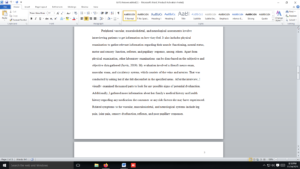Peripheral-vascular-musculoskeletal-and-neurological-assessment
Peripheral-vascular-
Weekly assignment: conduct an assessment on the following body systems:
You may conduct the assessment on a fellow student, friend, or family member. Remember to secure their permission.
Collect both subjective and objective data using the process described in the textbook.
- What skills (assessment techniques) were utilized during the assessment?
- What subjective data did you collect? (list your findings)
- What objective data did you collect? (list your findings)
Answer preview
Peripheral vascular, musculoskeletal, and neurological assessments involve interviewing patients to get information on how they feel. It also includes physical examination to gather relevant information regarding their muscle functioning, mental status, motor and sensory function, reflexes, and pupillary response, among others. Apart from physical examination, other laboratory examinations can be done based on the subjective and objective data gathered (Jarvis, 2019). My evaluation involved a friend’s neuro exam, muscular exam, and circulatory system, which consists of the veins and arteries. That was conducted by asking her if she felt discomfort in the specified areas. After the interview, I visually examined the named parts to look for any possible signs of potential dysfunction. Additionally, I gathered more information about her family’s medical history and health history regarding any medication she consumes or any risk factors she may have experienced. Related symptoms to the vascular, musculoskeletal, and neurological systems include leg pain, joint pain, sensory dysfunction, reflexes, and poor pupillary responses.
[941 Words]

Peripheral-vascular-musculoskeletal-and-neurological-assessment

